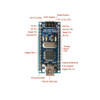Description
Arduino Nano 3.0 Board with ATmega328 A000005
The Arduino Nano is a small, complete, and breadboard-friendly board based on the ATmega328 (Arduino Nano 3.0) or ATmega168 (Arduino Nano 2.x). It has more or less the same functionality of the Arduino Uno, but in a different package. The Nano was designed and is being produced by Gravitech.
Why choose Arduino Nano?
Obviously its size makes the Arduino Nano stand out from the family. However it holds much of the same functionality of comparable boards. The main difference is lack of DC power jack and it works with a Mini-B USB cable, rather than a standard USB.
The Arduino Community
There is a huge community surrounding Arduino. So, if you are ever stuck or require some guidance with your projects, the Arduino site is full of content to keep you going. Or, if you find you are stuck for ideas to tinker about with, there’s plenty of projects on the site to give you some inspiration: http://labs.arduino.org/
Technical Specification
| Microcontroller | Atmel ATmega168 or ATmega328 |
| Operating Voltage (logic level) | 5 V |
| Input Voltage (recommended) | 7-12 V |
| Input Voltage (limits) | 6-20 V |
| Digital I/O Pins | 14 (of which 6 provide PWM output) |
| Analog Input Pins | 8 |
| DC Current per I/O Pin | 40 mA |
| Flash Memory | 16 KB (ATmega168) or 32 KB (ATmega328) of which 2 KB used by bootloader |
| SRAM | 1 KB (ATmega168) or 2 KB (ATmega328) |
| EEPROM | 512 bytes (ATmega168) or 1 KB (ATmega328) |
| Clock Speed | 16 MHz |
| Dimensions | 0.73" x 1.70" |
If you want to give a closer look to this board we advise you to visit the official in the Hardware Section.
1 Review
-
Title of review 446
The Nano (v3.0) has a nasty gotcha: it works fine when plugged into an already-running PC, but if the Nano is already connected when the PC is cold-booted (from power-off), the nano won't be recognised. This is because of a floating test pin on the FTDI23.


















